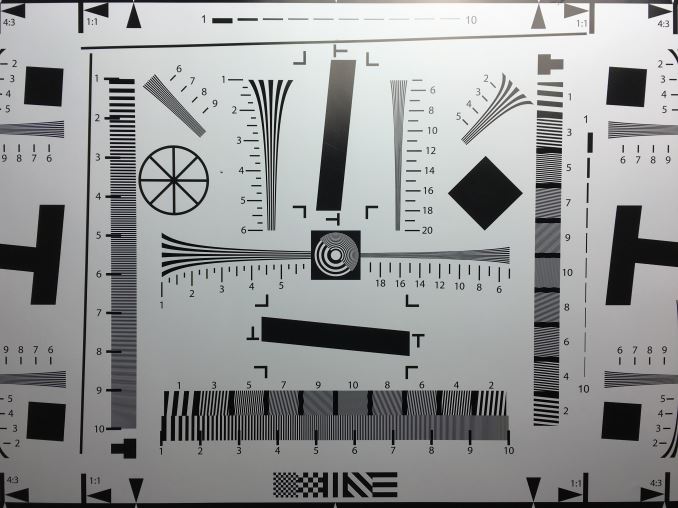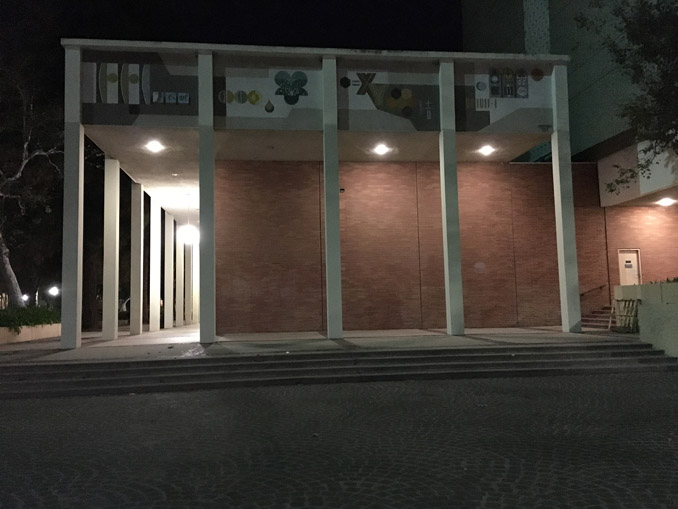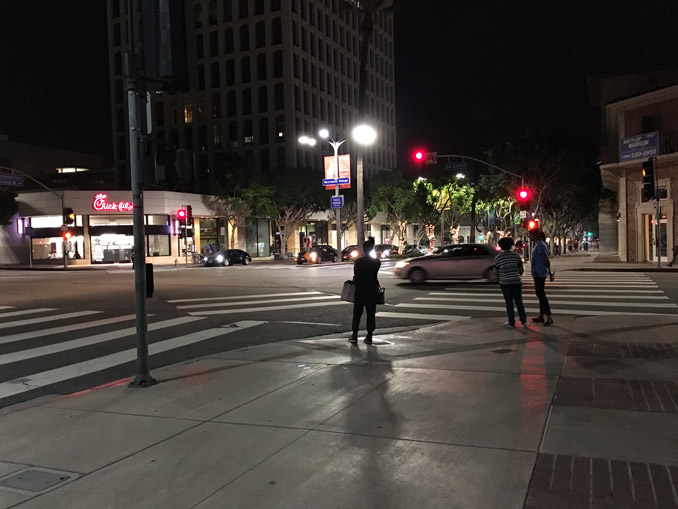The Apple iPhone 6s and iPhone 6s Plus Review
by Ryan Smith & Joshua Ho on November 2, 2015 8:00 AM EST- Posted in
- Smartphones
- Apple
- Mobile
- SoCs
- iPhone 6s
- iPhone 6s Plus
Still Image Performance
Now that we’ve discussed the user experience and still image quality we can start to compare the end result after taking photos. For those unfamiliar with how we test photos, we rely on a combination of controlled lighting tests and relative real-world comparative tests. In the interest of better-controlled testing I’m hoping to make a move towards more controlled testing in the future but for now relative comparisons in mostly identical conditions should give a pretty good idea for what to expect from a camera.
Looking at our standard resolution test, the iPhone 6s has visibly more detail than the iPhone 6, but we're basically looking at the ideal case here. Both phones have some noticeable haloing around high-contrast edges to enhance perceived sharpness but the iPhone 6s manages to keep smoother edges in the image and less distortion of the closely spaced line pairs in the center of the image. Given how subtle some of these changes are I suspect that in real-world situations it would be difficult to tell the difference between the iPhone 6s and iPhone 6 for overall image detail.
| Daytime Photography |
Our first real-world test is a daytime shot. Compared to something like the iPhone 6 in this test, oddly enough there isn’t a huge improvement, which suggests that either that noise reduction is reducing overall detail in the image or that the optics are actually the limiting factor in resolution. The Note 5 does hold an advantage here by virtue of larger sensor size and just more pixels to work with. However when compared to some of the other phones on the market like the One M9 Apple actually manages to produce a better image despite their sensor size deficit and pixel count deficit.
The same scene with HDR enabled shows that Apple is relatively conservative when it comes to how strong they make their HDR effects. Once again something like the Note 5 is clearly better here when it comes to detail and overall dynamic range, but Samsung does push a bit too far when you look at some shadows as the trees in the left half of the image have noticeable color artifacts. Interestingly enough, LG is the clear leader here when it comes to dynamic range and detail but they do have a problem with some excessive sharpening and some color artifacts when we look at some really extreme long distance detail. Apple does need to improve HDR here, as the latency for an HDR photo is quite long and the difference between HDR on and off is rather subtle in situations where it shouldn't be subtle.
| Low Light Scene 1 |
Moving on to the same scene shot in low light, it’s almost kind of shocking to say this but the iPhone 6s is better than the iPhone 6 here in low light. However, this does come at the cost of more visible luminance noise which suggests that we’re looking mostly at differences in post-processing. The same is true of the iPhone 6s Plus when compared to the iPhone 6 Plus, which is kind of surprising but given that in low light we’re mostly limited by the sensor rather than the available light it makes sense that sensor-level improvements eliminate the disadvantages associated with small pixel sizes.
Relative to the Galaxy Note 5, the iPhone 6s Plus is pretty close here but the Note 5 does have an edge in detail. However, the post-processing has noticeably more artifacts such as the odd streak on the left side of the image which is due to stray light. The iPhone 6s Plus also does a better job of freezing motion of the people walking on the stairs, which is likely due to their image combination techniques to reduce motion blur that would otherwise be evident due to the long exposures used. The G4 might look better to some people but detail is similar to the iPhone 6s Plus with the motion blur of the Note 5, so it ends up behind both.
| Low Light Scene 2 |
In the interest of gathering more data points for low light camera performance, I decided to try and find a relatively uniform low light scene that stresses detail more strongly. Here, once again the iPhone 6s and 6 are pretty similar but the iPhone 6s has better detail at the expense of more noise. Relative to the iPhone 6 Plus, the iPhone 6s Plus ends up with better detail as well. The iPhone 6s Plus is actually arguably better than the Note 5 here by virtue of more accurate color and better details. For whatever reason in some very low contrast areas Samsung is just blurring away details in their post-processing that Apple is retaining. The ground is clearly more detailed as well. This seems counter-intuitive but this is really just Apple’s processing here as they’re getting away with an absurdly long exposure time without the associated motion blur that you might expect from a quarter second exposure. Once again, the LG G4 actually manages to beat the Note 5 and iPhone 6s Plus in absolute detail here despite the much higher sensor gain selected for this scene. The OnePlus 2 in this scene looks pretty similar to the iPhone 6s Plus, but with more color noise and a bit more blur at 100%.
| Low Light Scene 3 |
In the interest of breaking things down even more, I decided to do one last low light test scene which is really more designed to see what motion blur occurs in low light than anything else. This is far from scientific but the iPhone 6s and 6s Plus are once again effectively equivalent at freezing motion, while the Note 5, G4, and almost every other phone I attempted to test this scene with is visibly worse at this. Weirdly enough, even though the Moto X 2014 and iPhone 6s are using the same shutter speed the iPhone appears to do a better job of maintaining detail. This is likely due to changes in image processing on the software side to try and reduce the effects but this is a rough estimate as I can’t control precisely how fast pedestrians and traffic move in this scene.
Overall, the iPhone 6s and 6s Plus are pretty consistently good cameras. In some ways Apple is losing out in raw detail for photos because they went with a smaller sensor size than most, but in general color reproduction, post-processing, and low light photo quality and overall camera UX Apple is leading quite strongly. To some extent, I would say that the Galaxy Note 5 and LG G4 are better in daytime just by virtue of their larger sensors, but in low light I would argue the iPhone 6s Plus is better by virtue of its ability to freeze motion while remaining competitive with the Note 5 and G4 for detail. The iPhone 6s by comparison is at least a few steps behind due to its lack of OIS, but this really only starts to matter when you hit the limits of the 2000 ISO and 1/15s exposure for a scene as the iPhone 6s Plus can push up to 2000 ISO and a 1/4s exposure.





















531 Comments
View All Comments
akdj - Tuesday, November 3, 2015 - link
Hi Josh and Ryan,Many, MANY thanks for the insight and in depth review. I've just finished my second read (it was late last night I noticed the review and read through) and your experiences mimic mine. With a single exception. I'm a business owner, have been over 26 years now and use phones for the business and personal. I also outfit employees so I have a chance to stay 'ambidextrous', keeping a foot in Android, rest of the body in iOS ... But some things I do enjoy on both my older Note 4, & newer S6. No intrigue with the Note 5 other than its SoC, speed of internal storage and design over my older N4. As an S6 Edge owner I'm well aware of the speeds uninstalling, installing apps, opening them, the 'feel" of the newer 2015 Sammy phones as well as the exceptional speed of the Exynos processor. That said, you made a remark I don't quite agree with
"The second generation of TouchID isn’t quite as life-changing, but it’s a welcome improvement nonetheless. Again, this is a case where there was friction in the user experience that wasn’t really noticeable until it was gone. Obviously, Apple is no longer the only one at this level of user experience with fingerprint scanners but they are keeping up."
I'm not sure which phone you've found that parities the iPhone 6s/6+s for FP register. As it's certainly not the S6/S6+/Note 5 or LG (I've got one of their freebie 8" LG tabs from AT&T runnin LP). I'm hoping anyway lol. My silly S6 is just finally starting to correctly register 50% of the time with the 5.1 update. The previous six months I was lucky to have my thumb recognized 1 of 5 times. And it's registered as FOUR different 'fingers'.
I'm also an owner of the 6+s and even checking the time or setting an Altman, turning the flashlight on, etc...it's so damn quick, I'm automatically on the home screen. It's ...pardon the pun, lightning fast and immediate. I guess I'm curious as to which OEM Apple is keeping up with as I had the 5s and 6+ standard as well. The Note 4 is a useless implementation and the S6, while better is a LONG way off from 'keeping up with...' Apple again IMHO. Genuinely curious as to the OEM making better or even similar performing and 'protective' measures than Apple.
Other than that silly nitpick, I agree completely and haven't enjoyed an iPhone as much since the iPhone 4 and its HiDPI display. If I recall, another 'first', wasn't it? (Like the 5s FP reader, actually able to 'read an FP ;)). Maybe it's my aging mid 40s eyes but the higher resolutions and larger displays have literally kept pace with my deteriorating vision!
Once again, many thanks for the perfectly balanced nerd/everyday 'Joe n Jane' subjective review of 'real world use'. Always refreshing to hear... I mean read your reviews, un-rushed to keep up with the herds the day after release or a week post NDA, minus the carrying around and using ...or simple resolution, 100% 'chart n number' reviews.
Loved it. And I'm loving the iPhone 6s+. It's truly a computer in my pocket. I know you briefly touched on the expanded radios both WiFi and LTE, another maybe at first unnoticeable unless ...again as you mention an iCloud restoration of significant size, but a HUGE end user boon. These are incredibly fast, seemingly more 'stable' in 5MHz mode. (Maybe a bad word, stable but hard to put my finger on it, as older modems on the iPhone with AC/5MHz or is it GHz? Now I'm lost. This one seems faster, more efficient and stable than earlier versions )
My wife has an identical iPhone 6+s. 128. Hers is Sammy mine TSMC. Neither has shown any significance in battery draw than the other. Mine measures 2238/4437 in GBench, hers 2242/4405 after six runs ...that's the mean. Power and efficiency are nearly identical after a weekend at our cabin we both had single digit %'s and used them nearly the same the entire weekend.
Very VERY great phone
J
MarcSP - Wednesday, November 4, 2015 - link
Thanks for your explanation :-). Still, I think there must be something else. I mean, most Samsung phones also use amoled and did not get such a low score in browsing, and the Snapdragon 800 is not a very slow SoC. Even today there are many low and even middle-end phones sold with weaker SoC.zodiacfml - Wednesday, November 4, 2015 - link
i dont like apple but their engineering and design is very impressive. i wonder how the new cpu compares to a Core M.tharun118 - Wednesday, November 4, 2015 - link
The best phone? Seriously? I've seen a lot of people saying iPhone as THE BEST phone, but AnandTech? Come on.. I believe that there can never be a "THE BEST phone". Yes, iPhone 6+ has a very good SoC, reliable camera, 3D Touch, etc, but like every flagship phone, there are compromises and drawbacks. For me, I choose a smartphone based on 4 major aspects. First, the screen. I know Apple lovers always defend their 320+ PPI screen saying that's more than enough and they don't need anything more. But the truth is, they are far behind Samsung and that will likely change in 7 or 7s. Second, the camera, this is purely subjective, there are people who'd prefer photos from an iPhone and there are people who'd prefer photos from 2015 android flagships (S6, Note 5, G4, 6P, etc). Third, battery and performance: Apple is better here on a tiny margin due their vertical integration. I think Android phones will never reach the exact smoothness in performance and efficiency in power consumption of the latest iPhone, due to fragmentation. Fourth, customisation: No comments here, but I understand there are lots of people who'd happily use their phone the way their manufacture tells them to. I'm definitely not one among them. I try to balance all these 4 aspects and my choice this year was a Galaxy S6. Of course, there are bonus features such as, wireless charging, quick charge (very useful), IR port, etc. But still, I wouldn't call S6 as THE BEST. Neither is an iPhone 6+.Vincog - Wednesday, November 4, 2015 - link
I got iphone 6S with samsung chip here, and my battery will decrease 1% every 5 minute in use or 1% every 15 minute standby... ( take a note all background refresh off, location off, only hey siri on ) ..Even my iphone 5s is more better than this one!! 😭😭😭😭Tigran - Wednesday, November 4, 2015 - link
***Looking at GFXBench, which is an infinite loop of the T-Rex on-screen benchmark to approximate intensive video gaming we see that the iPhone 6s doesn’t last very long either, but the performance throughout the test is incredible. Due to 1334x750 display resolution and strong GPU, the iPhone 6s manages to last the entire test without any notable throttling, and effectively pegged at the refresh rate of the display.
***
Why V-Sync (which limits T-Rex on-screen by 60 fps) is ignored? And what about this throttling evidence (by 20-22% in GFXBench off-screen):
http://forums.anandtech.com/showpost.php?p=3772777...
blackcrayon - Wednesday, November 4, 2015 - link
They mentioned that the 6s+ throttled slightly due to the higher resolution, so it stands to reason that the 6 would also throttle when rendering a higher resolution offscreen. But it's nowhere near the throttling of any of the competitors, games are still remaining playable throughout a reasonable gaming session.Tigran - Wednesday, November 4, 2015 - link
You don't get it. It's not about resolution - it's about T-Rex on-screen which limits performance to 60 fps. Without this limit iPhone 6s performance would be much higher, so it is incorrect to mention T-Rex on-screen discussing iPhone 6s throttling. If there is throttling, it can decrease from 100 to 70 fps, but you will see only 60 fps during the whole test - because of V-Sync. And there is evidence off throttling in Manhattan (which doesn't reach 60 fps limit) actually - see my link above (20-22% throttling). I can add that popular Russian laboratory (overclockers.ru) tested throttling of iPhone 6s via Basemark Metal, and they found enormous throttling there - from 911 down to 525 (74%).zhiliangh - Wednesday, November 4, 2015 - link
Thank you! I have been waiting for your review before upgrading any phone this year. This is a must-read iphone review.Spunjji - Wednesday, November 4, 2015 - link
I have a bit of a gripe regarding the conclusions in the camera section. The LG G4 is clearly providing better images at night than the iPhone 6s and 6s Plus - granted there is "less motion blur" in the Apple images, but they're also quite clearly underexposed by at least a stop. It therefore seems odd to conclude that a product which produces grainier, less-detailed and murkier images than the competition is better. You could produce similarly non-blurry results on the G4 by adjusting exposure compensation and then have the best of both worlds!